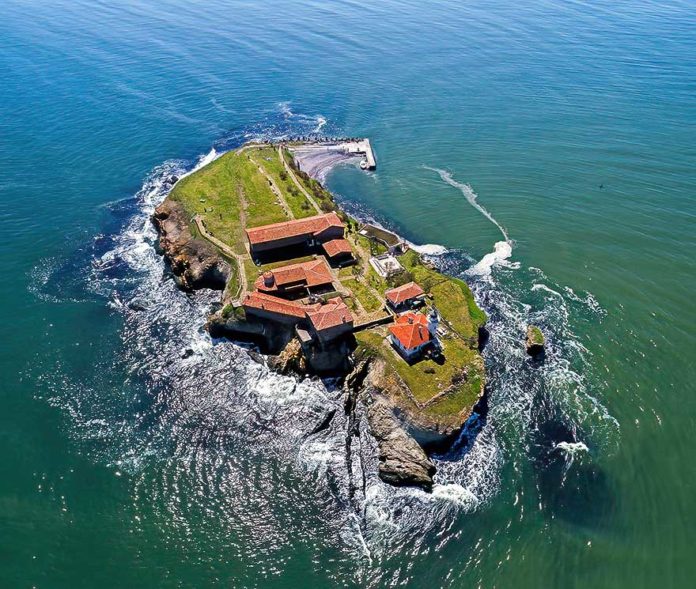The History
Saint Anastasia Island, also known as “Bulgaria’s Alcatraz”, is a small island in the Black Sea near Burgas. The island’s rich and varied history dates back to late antiquity. The island was first plotted on the map of the Black Sea by the Dutch cartographer Nikolaos Witsen in the last decade of the 17th century. The island is also home to the only island monastery in Bulgaria, the “Saint Anastasia Pharmacolitria” monastery, part of which has been preserved to this day.
The earliest records of the monastery’s existence date back to the 15th century. Over the years, the monastery has undergone many changes and renovations due to fires and pirate attacks. The monastery church, “Assumption”, is a small stone building strengthened with wooden pillars. The church’s oldest part was converted into an altar, and the remarkable wooden iconostasis from 1802 stands between it and the later extension of the monastery church. In 1772, a stone building was constructed, and at the beginning of the 19th century, an inscription testifying this construction was built into the newly built match.
The St. Anastasia Island After 1923
In the 20th century, the monastery was converted into a “Bulgaria’s Alcatraz” prison. In 1923, 132 communists and farmers exiled to the island were housed in the prison. The problematic maintenance of the island prison forced the government to transfer the prisoners to the Burgas police station, and some of them were released.
After the attack on the Sofia church Sveta Nedelya in April 1925, the island was again turned into a prison, and 43 prisoners escaped in two rowing boats to Cape Chukalya, from where they hid in Strandzha mountain. In their memory, one of the wings of the monastery was later converted into a museum.
The Lighthouse on the Island
The island is also known for its lighthouse, built by a French company, Collas et Michel, in 1863 and first lit on August 8th. The lighthouse was mounted on an iron pole raised 40 meters above sea level, and in good weather, its light could be seen from 10 miles away. In 1912, the foundations were laid for a new lighthouse in the island’s northern part, which still guides ships today. The acrylic plate of the headlight optics is in a remarkably pristine condition, and upon closer inspection, it reveals the year of its manufacture to be 1883. The optic was produced by the reputable Paris-based company Barbier & Fenestre, later known as Barbier, Benard & Turenne. It is awe-inspiring to note that this headlight optic has been functioning flawlessly for a staggering 135 years, a testament to the impeccable quality of its craftsmanship and the advanced technological expertise of the manufacturer.
Optics of the Lighthouse
The path the optics take to reach the lighthouse on Saint Anastasia Island is fascinating. The renowned French company Collas et Michel delivered the optic for the lighthouse constructed in December 1883 on the island of Saint Ivan. In 1911, a new white circular reinforced concrete lighthouse tower was built, and Barbier, Benard & Turenne manufactured new optics on March 15, 1911. The old optics were transferred and installed on the lighthouse on Saint Anastasia Island. The new lighthouse tower was built in 1914, and the lighthouse optics began operating from the new lantern department on June 13, 1914.
Although the Saint Anastasia lighthouse optics have remained unchanged for many years, the way the light is ignited has undergone several transformations. From a two-wick oil lamp, the lighthouse moved to an electric bulb, which has now been replaced by modern LED lighting (LED lighting SM – 20P2), which has an autonomous power supply provided by a photovoltaic panel. LED lighting has been in operation since 2014. However, the old light bulbs have not been retired and remain as spares in the socket of the headlight optics, ready to replace the new lighting if necessary. The beacon continues to shine unfailingly with its familiar characteristic: group flashing white and red light, with a light duration of 2 seconds and a dark duration of 6 seconds, with a visibility of 20 miles.
The Boheme Period
From the 1960s to the 1980s, Saint Anastasia Island became a favorite place for Burgas’s creative bohemians. During this period, the great Burgas poet Hristo Fotev spent much of his time on the island, and many residents called him its “governor”. At that time, the island had a restaurant, a small hotel, a church, and a pier.
Today
Today, the island is known for its rich cultural and historical heritage, offering visitors a unique experience. The island has an apothecary offering miraculous herbs and potions, and visitors can also spend the night in a monastery cell from the Middle Ages. A restaurant on the island serves authentic Burgas dishes according to old recipes. The island is also a popular location for films, and several movies have been filmed there, including “On the Small Island” and “The Island” starring Leticia Casta.
Since 2001, Saint Anastasia Island has been declared a cultural and historical landmark.



